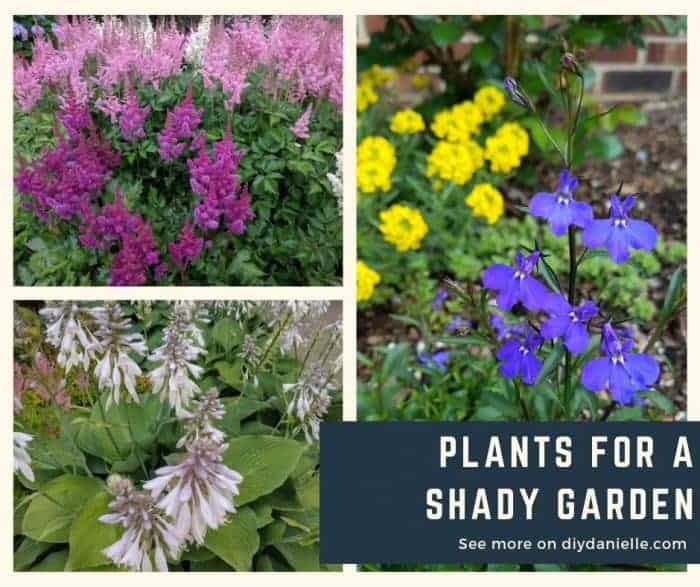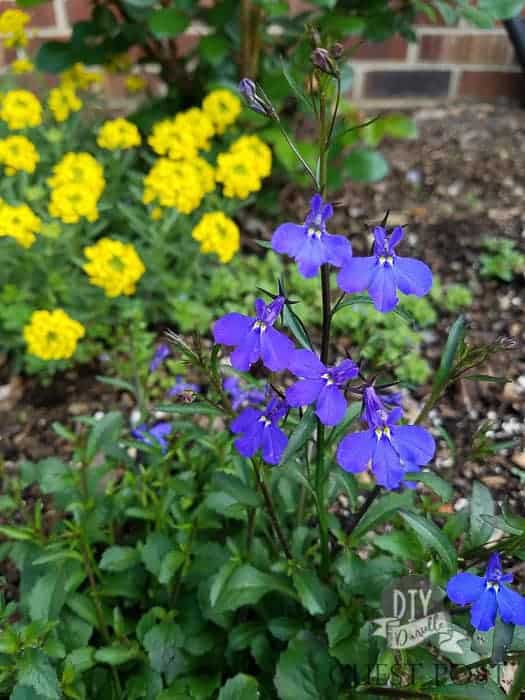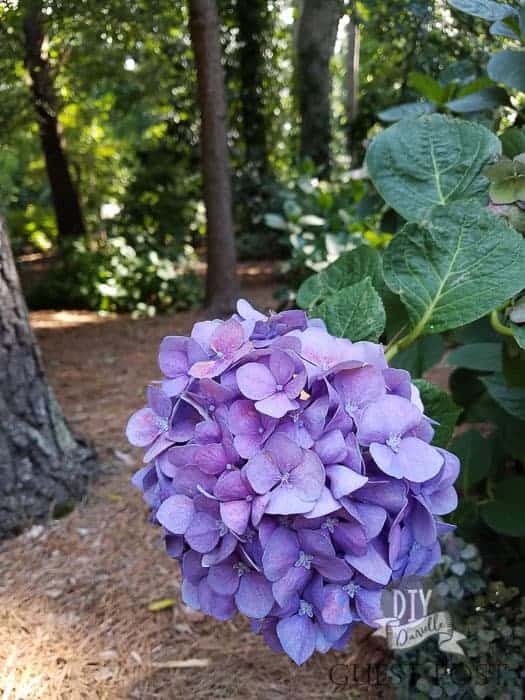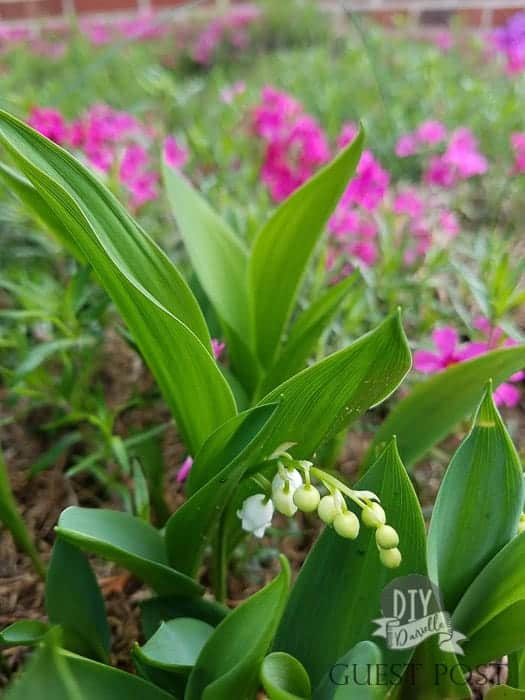
Must have shade garden plants that will balance and beautify your garden beds.
This post may contain affiliate links which may earn me commissions should you click through them and take certain actions. As an affiliate for Amazon, Cricut, xTool, Home Depot, and other sites, I earn from qualifying purchases. Please DIY carefully. View my full legal disclosures here.
Please read the whole post so you don’t miss any important information!
Adriana is here to guest post about shade garden plants today. Please welcome her and check out her blog, Backyard Garden Lover. -Danielle
Once the brilliant chorus of spring and early summer flowers has faded, it’s easy to let shaded spaces slide into all-green summer doldrums. Fortunately, careful plant selection makes it possible to keep summer shade gardens looking alluring.
The first line of defense against an all-green summer garden is plants that feature variegated foliage. There also are perennials that bloom in summer, and the ones listed here are well worth planting.
To design a garden that lights up a shady spot in the summer, try landscaping with drifts of shade-loving flowers that bloom after the main burst of early season color fades. Planting several of the same flowers will make a bigger impact than adding one of each. Move your plants around before your set them in place: see what’s more pleasing to your eyes, what goes best with the area you’re trying to enhance.
Best Plants For Shade Gardening
Shade loving foliage
Start your garden planning by making space for perennials that feature handsome variegated foliage.
Hostas top the list here, and there are countless cultivars in all sizes that warrant selection for shade gardens. Here are hostas you might consider:
- 8-inch-tall ‘Kabitan’ with chartreuse and green leaves
- 12-inch ‘Golden Tiara’ with green leaves edged in gold
- 2-foot ‘Inniswood’ with gold leaves edged in dark green
- 6-inch ‘June’ with leaves striped in yellow-green, chartreuse, blue-green, and dark green
While all hostas produce flowers in mid to late summer or early fall, some are more effective than others. H. ventricosa produces 3- to 4-foot stalks of striking purple flowers above the foliage in late summer. Its cultivar ‘Aureomarginata’ brings yellow-variegated leaves to the garden in addition to flowers. (Get hosta seeds on Amazon)

Other shade-loving plants with striking foliage include:
- Spring-blooming polemoniums (Polemonium spp.) , commonly called Jacob’s ladder
- Variegated fragrant Solomon’s seal (Polygonatum odoratum var. thunbergii ‘Variegatum’)
- Japanese painted fern (Athyrium nipponicum var. pictum)
- Heucheras (Heuchera hybrids)
Shade loving summer flowers
While you can always add color to a shade garden with annuals like wax begonias and impatiens, there are perennials that flower in summer. Consider some of the following to add a seasonal progression of bloom to your shady beds and borders.
Lobelia blooms display a gorgeous blue color: great in your shade garden, or in a hanging basket.

Hydrangea bushes can put on quite a show in the summer. Did you know that with a bit of chemistry, you can tweak hydrangea’s colors? Learn how to change hydrangea colors from pink to blue, blue to pink, and even turn your blooms to shades of purple.

Lily of the valley blooms in tiny bell shaped flowers that do great in the shade. In some parts of the country, they can be considers invasive, so find out if you live in such an area. I’m in zone 6a and don’t have this problem. The smell of these adorable flowers is heavenly, and they are very easy to care for: pretty much plant and forget. If you want to grow your own patch of lily of the valley, you might find some of these tips helpful.

Gorgeous, showy, perennial flowers with fern like foliage, astilbes have many plants to choose from:
- Chinese astilbes (Astilbe chinensis) bloom from midsummer to fall, unlike the more common hybrid astilbes. They feature fern-like foliage and lacy plumes of purplish pink flowers.
- Dwarf Chinese astilbe (A. chinensis var. pumila) has 6-inch-tall foliage and blooms that reach 1 foot.
- Purple-pink A. chinensis var. davidii can reach 4 to 6 feet in bloom in rich, moist soil from late spring to early summer.
- A. chinensis var. taquetii, along with its cultivars ‘Superba’ and ‘Purple Lance’ bear red-purple flowers on 4-foot plants from midsummer to fall. All need partial shade and rich, constantly moist, well-drained soil. Afternoon shade is essential in southern zones.

Indian pink (Spigelia marilandica) is an eye-catching native wildflower that is still a rare sight in gardens. Plants bear striking clusters of bottle-shaped scarlet flowers topped with yellow at the tips. They are 12 to 18 inches tall and thrive in partial shade and rich, moist soil. Indian pink is slow to establish, so be patient and give plants time to grow. ( Get seeds from Amazon).
Lamiums or spotted deadnettles (Lamium maculatum) bring silver, or white variegated foliage and clusters of small red-purple, pink, or white flowers in summer to the garden. ‘White Nancy’ bears white flowers and silver leaves with green edges, and there are a number of other cultivars available. These low-growing plants range from 8 to about 10 inches tall and make fine ground covers. Give them partial to full shade and average to rich soil that’s moist but well-drained. Zones 3 to 8.
Rodgersias (Rodgersia spp.) bear creamy white or pink flowers above stout clumps of leaves that form 2- to 4-foot-tall mounds, depending on the species. The plumy flowers resemble large astilbes. Rodgersias need partial to full shade and rich, moist soil. They’re ideal for a site along a stream or pond where soil moisture is consistent. (Get the seeds on Amazon)
Cimicifugas or snakeroots (Actaea spp., formerly Cimicifuga spp.) are large, handsome perennials that range from 2 to 8 feet, depending on the species. Plants bear attractive compound leaves and showy racemes of tiny white flowers. By selecting more than one species you can have cimicifugas in bloom from midsummer to fall. Two native species bloom in summer:
- American bugbane in late summer, midsummer in the South
- Black snakeroot (A. racemosa formerly C. racemosa) in midsummer.
Give cimicifugas partial to dappled shade and rich, evenly moist soil. (Get the seeds on Amazon)
How to care for your summer shade garden
To ensure that your shade garden will be thriving, keep the soil mulched in summer, and be sure to water as necessary. While well-mulched, established perennials can withstand short periods of dry soil, longer periods of drought will cause crispy leaf edges and reduced bloom. To help retain soil moisture, get in the habit of adding a shovel full of compost or other organic matter to the soil every time you dig.
I hope you have some new ideas for shade loving plants you might want in your garden. Don’t stop with these plants. Experiment with new ideas every year: learn the best plants for your area, and have fun.
About the Author: Originally from Romania, and now living in the beautiful Shenandoah Valley, Adriana loves the simple pleasures in life: time with her family, working in the garden, coking from scratch, naturel remedies and blogging. You can see her garden adventures at Backyard Garden Lover and follow her on Facebook and Pinterest.
Interested in gardening? Here are some other posts about gardening that I’ve written and you might enjoy: DIY Concrete Planters | Privacy Planters | How to Use Pine Straw as Mulch | 13 Stunning & Easy Garden Trellis Ideas | How to Setup a Pond and Patio | Gifts to Make from the Garden | Everything You Need to Know about Grow Lights
Please share and pin this post!

